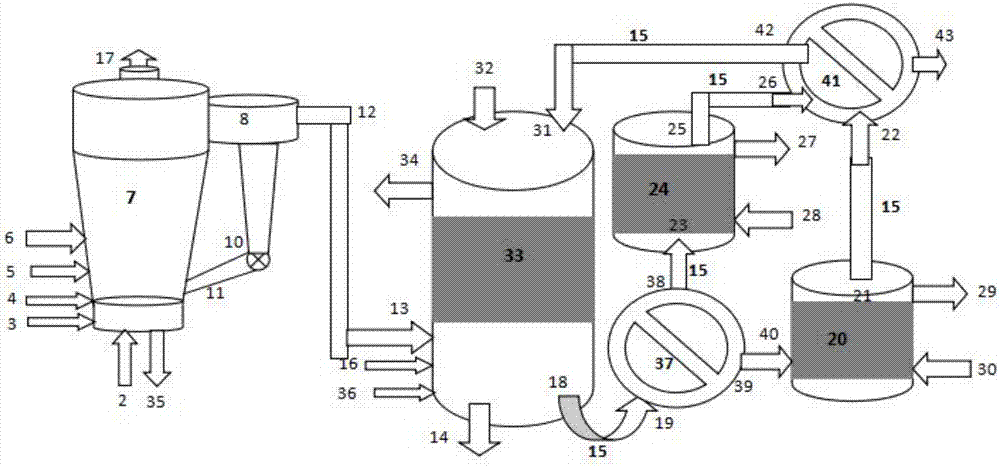Process for producing hydrogen by combining biomass gasification in circulating fluidized bed with H2 adsorption enhanced water vapor transformation
A circulating fluidized bed and water vapor shift technology, applied in the field of chemistry, can solve the problems of high cost, energy consumption and cost, and achieve the effects of improving carbon conversion rate, improving gasification intensity, and prolonging residence time
- Summary
- Abstract
- Description
- Claims
- Application Information
AI Technical Summary
Problems solved by technology
Method used
Image
Examples
Embodiment 1
[0047] Using biomass straw as raw material, according to the mass ratio of straw primary feed and secondary feed 1:4, the air used in circulating fluidized bed 7 is based on the ratio of the number of oxygen moles in the air to the number of carbon moles in the primary feed of biomass: 1:1.1, the water vapor used is 4:1 according to the ratio of the moles of water vapor to the carbon moles in the secondary biomass feed, and the amount of quicklime is 4 according to the mass ratio of its Ca content to the secondary biomass feed. %, the steam of the gasification agent enters the circulating fluidized bed 7 furnace and sprays it at an angle of 25 degrees downwards, and the circulating fluidized bed 7 burns and gasifies the biomass, and the generated syngas enters the H 2 In-situ adsorption enhanced water vapor shift moving bed reactor 33, according to the carbon, water vapor and nitrogen in the biomass secondary feed according to the molar ratio C:H 2 O:N 2 It is 1.78:5.35:20.8,...
Embodiment 2
[0049] Using biomass straw as raw material, according to the mass ratio of straw primary feed and secondary feed of 1:3, the air used in circulating fluidized bed 7 is based on the ratio of the number of oxygen moles in the air to the number of carbon moles in the primary feed of biomass: 1:1, the water vapor used is 3:1 according to the ratio of the number of moles of water vapor to the number of carbon moles in the secondary feed of biomass, and the amount of quicklime is 3 according to the mass ratio of the Ca content to the secondary feed of biomass %, gasification agent water vapor enters the nozzle angle of the circulating fluidized bed furnace 7 and injects it at an angle of 25 degrees downwards, and the circulating fluidized bed 7 burns and gasifies the biomass, and the generated synthesis gas enters the H 2 In-situ adsorption enhanced water vapor shift moving bed reactor 33, according to the carbon, water vapor and nitrogen in the biomass secondary feed according to th...
Embodiment 3
[0051] Using biomass straw as raw material, according to the mass ratio of straw primary feed and secondary feed of 1:5, the air used in circulating fluidized bed 7 is based on the ratio of the number of oxygen moles in the air to the number of carbon moles in the primary feed of biomass: 1:1.1, the water vapor used is 4:1 according to the ratio of the number of moles of water vapor to the number of carbon moles in the secondary biomass feed, and the amount of quicklime is 5 according to the mass ratio of its Ca content to the secondary feed of biomass %, gasification agent water vapor enters the nozzle angle of the circulating fluidized bed furnace 7 and injects it at an angle of 25 degrees downwards, and the circulating fluidized bed 7 burns and gasifies the biomass, and the generated synthesis gas enters the H 2 In-situ adsorption enhanced water vapor shift moving bed reactor 33, according to the carbon, water vapor and nitrogen in the biomass secondary feed according to the...
PUM
 Login to View More
Login to View More Abstract
Description
Claims
Application Information
 Login to View More
Login to View More - R&D
- Intellectual Property
- Life Sciences
- Materials
- Tech Scout
- Unparalleled Data Quality
- Higher Quality Content
- 60% Fewer Hallucinations
Browse by: Latest US Patents, China's latest patents, Technical Efficacy Thesaurus, Application Domain, Technology Topic, Popular Technical Reports.
© 2025 PatSnap. All rights reserved.Legal|Privacy policy|Modern Slavery Act Transparency Statement|Sitemap|About US| Contact US: help@patsnap.com

